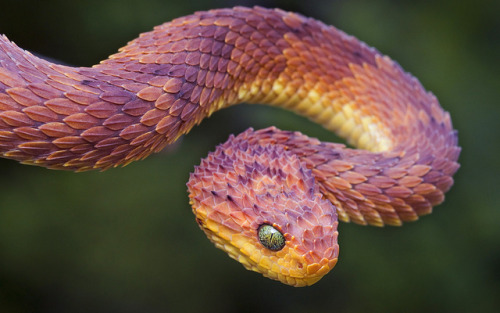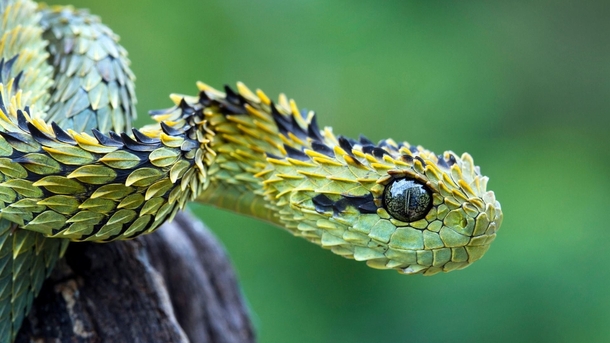Atheris
Green Bush Viper ( Atheris squamigera )
The bush vipers ( Atheris ) are a genus exclusively in Africa common venomous snakes of the family of vipers ( Viperidae ) with 8 to 12 known species. There are snakes, which are adjusted by the formation of a prehensile tail and a change in the Bauchbeschuppung especially for life in the trees.
- 4.1 Documents cited
- 4.2 Literature
- 4.3 External links
Features
The types of bush vipers are primarily at an arboricole, ie a way of life in the trees adapted. They have accordingly a number of derived features compared to the primarily ground-dwelling species such as the viper closely related puff adders ( Bitis ) and the sand race wabble ( Echis ).
All bush vipers are with maximum body length of 60 to 80 centimeters relatively small, they are also very slender and flattened laterally, so that they are significantly lighter built as a bottom dwelling vipers. The head is broad and deposed by a narrow neck clear from the body. The tail is rolled up and therefore suitable for grasping and clinging to branches. In the coloring bush vipers can accept a wide range of brown and green tones to intense yellow or blue colors.
The top of the head is covered by many small and mostly smooth head scales, larger head shields do not exist in the bush vipers. The eyes have vertical pupils, and are separated from the supralabials by one to three rows of scales and of the nasals by two to three scales. A special form of the supraorbital scales can be found in the Usambara bush viper (A. ceratophora ); here the scales are extended eyebrow similar.
The dorsal scales are strongly keeled and overlap each other, the ventral scales are keeled smaller and less strong. Around the middle of the body possess bush vipers 14-36 scale rows. The Ventralia are rounded, the species have 133-175 ventral scales this. This is followed by the Analplatte and 38-67 undivided Subcaudalia.
Distribution and habitat
The spread of bush vipers is limited to Africa, doing all kinds in Central Africa occur. Being the westernmost species, the Black Green Bush Viper apply (A. nitschei ) with deposits in Guinea and the Atheris described only in 2002 hirsuta from the Ivory Coast.
System
The genus was first described by Atheris Edward Drinker Cope in 1862. He used this individuals the Western bush viper (A. chlorechis ) that were previously performed in the now-defunct genus Chlorechis.
External system
Within the Real vipers ( Viperinae ), the bush vipers with the swamp viper ( Proatheris superciliaris ) is the only species of the genus Proatheris, the East African mountain viper ( Montatheris Hind ) is the only species of the genus Montatheris and Uzungwe Viper ( Adenorhinos barbouri ) is the only type of combined to form a monophyletic genus Adenorhinos taxon Atherini. The genera Proatheris and Montatheris were introduced at a revision of the genus Atheris due to their morphological and immunological differences of plasma albumins to the other Atheris species in 1996 as new genera ..
The Swamp Viper is probably the most primitive kind, the sister species of all other Atherini represent the exact phylogenetic position of East Africa 's viper is unknown and the Uzungwe Viper is after the DNA findings of Lenk et al. 2001, despite morphological differences, the sister species of the Usambara bush viper ( Atheris ceratophora ) within the bush vipers. The bush vipers set accordingly in relation to these outsourced Uzungwe 1965 Viper not a natural taxon, the snake will be classified according to when a new revision again in the Atheris.
Internal system
Depending on the source of the species comprises a different number of ways. Thus, by 2011 between eight and twelve species were listed. Add to this the only in 2011 first described A. matildae.
The species known today are following after Mallows ( Atheris matildae was subsequently added):
- A. acuminata
- A. broadleyi
- Usambara bush viper (A. ceratophora )
- Western bush viper (A. chlorechis )
- Mount Kenya bush viper (A. desaixi )
- A. hirsuta
- Rauschuppen bush viper (A. hispida )
- Shaba bush viper (A. katangensis )
- A. matildae
- Black Green bush viper (A. nitschei )
- A. rungweensis
- Green bush viper (A. squamigera )
- Lowland Bush Viper (A. subocularis )
Documents
Cited evidence
The information in this article originate for the most part the limits given in literature sources, in addition, the following sources are cited:










